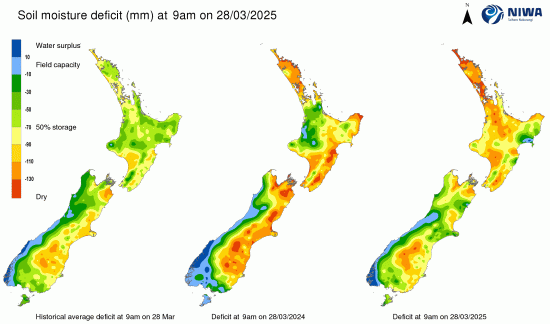Here's our summary of key economic events overnight that affect New Zealand with news financial markets are sensing a turn lower in the giant US economy and a risk-off tone is spreading. Impending new tariff announcements there are casting a pall over everything.
First, despite another fall in long term mortgage interest rates, US mortgage applications were weak last week. They fell by -2% in the week following a -6.2% drop in the previous week. Applications to refinance a home loan decreased -5% to the lowest level in a month. But applications for a mortgage to purchase a new home rose +1%.
New American durable goods orders in February unexpectedly rose +0.9% from January, following an upwardly revised +3.3% jump that prior month. This February result was much better that the anticipated -1% fall. But year-on-year the gain was just +0.5% and the result was largely ignored by financial markets, partly because it isn't expected to signal any longer improvement. One-off defence aircraft orders (+9.3%) accounted for most of the gains. Non-defence, non-aircraft orders for capital goods were -1.2% lower in February than a year ago. Markets noticed that.
They probably also noticed the latest update of the Atlanta Fed's GDPNow tracking showing a current estimate of Q1-2025 economic activity shrinking at a -1.8% rate. This updated real-time estimate is unchanged from last week. It is also worth noting that the benchmark "Blue Chip Consensus" forecasts are starting to waver now too as the quarter comes to an end.
Across the Pacific, Singapore's industrial production took quite a tumble in February from January, enough to turn its year-on-year change from a +8% rise in January into a -1.3% decline in February. The month-on-month reversal was a very sharp -7.5%.
In Europe, the UK said their inflation rate dipped to 2.8% in February from 3.0% in January, marginally below market expectations of 2.9%, though in line with the Bank of England's forecast.
In the EU, facing security threats from Russia, and a US 'ally' that is pulling back and effectively encouraging Moscow, is saying every citizen should stockpile enough food to be self-sufficient for at least 72 hours in case of crisis. Most EU states are sharply raising defence preparedness.
Australia is in its post-budget debate period. No announcement yet on an election date but it is widely expected over the next few days.
The UST 10yr yield is now at 4.34%, up +4 bps from yesterday at this time. The key 2-10 yield curve is steeper at +34 bps. Their 1-5 curve inversion is -2 bp. And their 3 mth-10yr curve is a positive +5 bps. The Australian 10 year bond yield starts today at 4.53% and up +4 bps from yesterday. The China 10 year bond rate is now at 1.88% and down -1 bp. The NZ Government 10 year bond rate is now at 4.62%, and again unchanged from yesterday.
Wall Street has started its Wednesday session and dipping further by -1.2% on the S&P500 on a tech sell-off. The Nasdaq is down -2.1%. Overnight, European markets were mostly down about -1.1% except London which rose +0.3%. Yesterday, Tokyo ended its Wednesday trade up +0.7%. Hong Kong was up +0.6%. Shanghai was little-changed again. Singapore was up +0.2%. The ASX200 ended its Wednesday trade up another +0.7% post-budget. And the NZX50 gained +1.2% on the day and again the best of the markets we follow.
The price of gold will start today at just on US$3016/oz and down a net -US$10 from yesterday.
Oil prices are up +US$1.50 from yesterday at just under US$70/bbl in the US and the international Brent price is now just on US$74/bbl. The new American tariff threats on using Venezuelan oil are disrupting supply.
The Kiwi dollar is now at 57.4 USc and unchanged from this time yesterday. Against the Aussie we are back up +10 bps at 91.1 AUc. Against the euro we are up +10 bps at just over 53.2 euro cents. That all means our TWI-5 starts today just on 67, and up +20 bps.
The bitcoin price starts today at US$86,866 and down -1.1% from this time yesterday. Volatility over the past 24 hours has again been modest at +/- 1.1%.
Daily exchange rates
Select chart tabs
The easiest place to stay up with event risk is by following our Economic Calendar here ».

7 Comments
Saw a great quote this morning:
I don't know what weapons will be used for WWIII, but WWIV will be fought with sticks and rocks.
Einstein.
Maybe, or maybe the next world war will be just that.. a war between worlds. Strap a few engines to an asteroid and send it across the planets orbit.
Either way, I hope I'm long dead before the next world war.
Redux.
"Private equity firms and Wall Street banks loaded American businesses up with debt from leveraged buyouts over the last decade and now they are loading them with more debt to cash out their winnings with an outlandish strategy, the “dividend recap.
...Now you may be asking yourself, why would JP Morgan and the other loan syndicate members make what seems to be a very risky loan?
They have options. The syndicate can sell into either a structure like a Collateralized Loan Obligation (CLO) or one of the many mutual funds that invest in these loans. As insane as it sounds, these loans are in incredible demand. It’s a lot like the subprime story in the 2000s—the tail is wagging the dog. CLO investors and mutual fund managers hunger for loans so Wall Street can make them without fear.
In fact the lenders make a fee putting the loans together and if they are a CLO underwriter, which they usually are, they get more underwriting fees."
https://www.racket.news/p/private-equitys-version-of-the-sting
The phrase "while the music plays, we have to dance" is a quote from Chuck Prince, the former CEO of Citigroup, that became a symbol of the risky financial decisions made on Wall Street leading up to the 2008 financial crisis.
meant for above conversation about wars....
this was only 5000 years ago
https://www.youtube.com/watch?v=Fri-lXx01x4
Burckle Mega Tsunami Ep 7: New Zealand's Mega Tsunami
5000 years ago, a comet broke apart into three pieces upon entry into Earth. The largest piece, smashed into the indian ocean, with the other two smaller pieces landing in different areas of the Pacific Ocean. The Indian Ocean impact, was incredibly disastrous. It landed in a very deep part of the ocean, and, as a result, it released a truly monstrous mega tsunami during impact. This tsunami was so disastrous, that 600 foot high mountains were built in Madagascar in the blink of an eye, when massive amount of churned up sediment that was carried by it, got deposited in truly vast quantities here, and everywhere else that this tsunami stuck, too, including very, very far places, such as Tasmania. When this Mega tsunami struck, it did so with such force, that it severely eroded entire cliff faces, and left deep gashing scars in the land, which document the direction the flow. Along with this, it also deposited something known as seismic chevrons. Which are arrow shaped hills of deposition, that were left after the wave had slammed into every coastline around the Indian ocean. When it began to recede, all the material it carried was just dropped where it landed, and the water move out, but the sediment remained. Because of this, massive layers of sand were deposited, and even though 5000 years have passed, you can still see many places where this tsunami impacted. In this episode of the Burckle Crater Mega Tsunami series, we take a look at the damage present in New Zealand, and, we journey from the South Island all the way up to the North Island, documenting the major damage along the way, aligning the chevrons with the epicenter, and explaining what recent changes have occurred to the land post deposition.
Bundling debt into new named formats and rebundling again, only to be sold on again and again at a profit? It sounds exactly like the cause of the subprime lead up to the GFC. There won't be bailouts this time. It sounds like we are one news story of a ratings agency taking bribes away, from absolute carnage.
In the US possibly, In NZ most retail mortgages are not securitized by the big 4, and if they are, its mainly for use as Repo collateral with the RBNZ.


We welcome your comments below. If you are not already registered, please register to comment.
Remember we welcome robust, respectful and insightful debate. We don't welcome abusive or defamatory comments and will de-register those repeatedly making such comments. Our current comment policy is here.